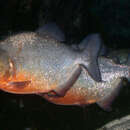Diseases and Parasites
provided by Fishbase
Ichthyobodo Infection. Parasitic infestations (protozoa, worms, etc.)
Diseases and Parasites
provided by Fishbase
Bacterial Infections (general). Bacterial diseases
Diseases and Parasites
provided by Fishbase
Eustrongylides Infestation 2 (Larvae). Parasitic infestations (protozoa, worms, etc.)
Diseases and Parasites
provided by Fishbase
Procamallanus Infection 10. Parasitic infestations (protozoa, worms, etc.)
Life Cycle
provided by Fishbase
Males and females appear externally alike (Refs. 2279 & 9245). In 'Serrasalmus sp. aff. nattereri', reported to occur in the Orinoco basin (Venezuela, Guyana), the males have more 'bull-like' heads, but are more slender than females (Ref. 1672). Eggs are laid on tree roots trailing in the water and are guarded; the reproductive success may vary strongly from year to year depending on how the savanna was flooded (Ref. 9078). The eggs are large, adhere to plants and are not attacked by the parents. They hatch in 9 to10 days (Ref. 7020).
- Recorder
- Crispina B. Binohlan
Morphology
provided by Fishbase
Dorsal spines (total): 0; Dorsal soft rays (total): 16 - 18; Analspines: 0; Analsoft rays: 27 - 30
Trophic Strategy
provided by Fishbase
Common in creeks and interconnected ponds in Matto Grosso, Brazil, where it influences distribution and feeding of other fish (Ref. 9080) and in areas of high primary production in Rio Machado and Rio Negro (Ref.9096). Adults feed mainly at dusk and dawn. Feeds on insects, worms and fish (Ref. 7020). Medium-sized to large individuals (15-24 cm length) forage mainly at dawn, late afternoon and night up to about 2200H, whereas smaller fish (8-11 cm) are active mainly during the day (Ref. 9080). Teeth replacement on alternating sides of jaw allows continuous feeding. Its powerful dentition can inflict serious bites. Has a highly evolved auditory capacity and a 'lurking', then 'dashing' behavior during daytime. Shows hierarchies within small schools (Ref. 9077).
- Recorder
- Crispina B. Binohlan
Biology
provided by Fishbase
Common in creeks and interconnected ponds in Matto Grosso, Brazil, where it influences distribution and feeding of other fish (Ref. 9080) and in areas of high primary production in Rio Machado and Rio Negro (Ref.9096). Adults feed mainly at dusk and dawn. Feeds on insects, worms and fish (Ref. 7020). Medium-sized to large individuals (15-24 cm length) forage mainly at dawn, late afternoon and night up to about 2200H, whereas smaller fish (8-11 cm) are active mainly during the day (Ref. 9080). Teeth replacement on alternating sides of jaw allows continuous feeding. Its powerful dentition can inflict serious bites. Has a highly evolved auditory capacity and a 'lurking', then 'dashing' behavior during daytime. Shows hierarchies within small schools (Ref. 9077). Available information on body composition of 'piranha caju' flesh is 8.2% fat, 15.0% protein and 4.4% ash (Ref. 9251).
Importance
provided by Fishbase
fisheries: minor commercial; aquarium: commercial

